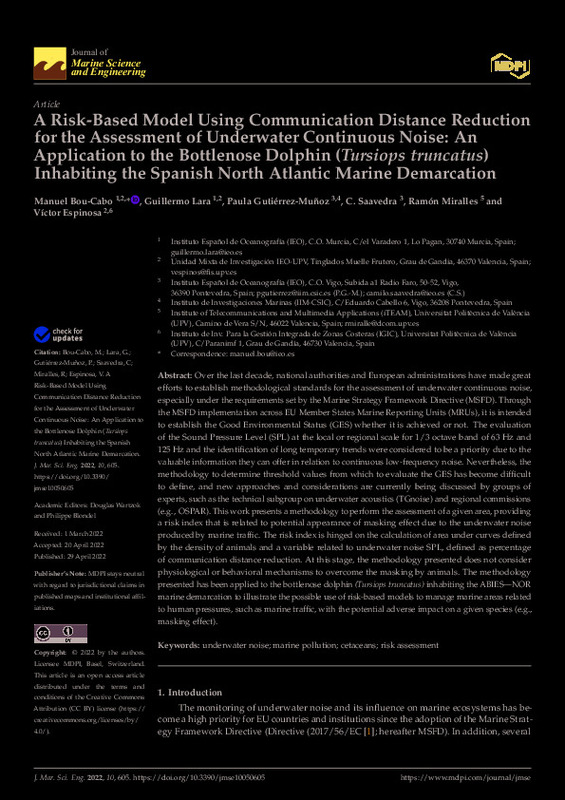

A Risk-Based Model Using Communication Distance Reduction for the Assessment of Underwater Continuous Noise: An Application to the Bottlenose Dolphin (Tursiops truncatus) Inhabiting the Spanish North Atlantic Marine Demarcation
RiuNet: Repositorio Institucional de la Universidad Politécnica de Valencia
JavaScript is disabled for your browser. Some features of this site may not work without it.
Buscar en RiuNet
Listar
Mi cuenta
Estadísticas
Ayuda RiuNet
Admin. UPV
A Risk-Based Model Using Communication Distance Reduction for the Assessment of Underwater Continuous Noise: An Application to the Bottlenose Dolphin (Tursiops truncatus) Inhabiting the Spanish North Atlantic Marine Demarcation
Mostrar el registro sencillo del ítem
Ficheros en el ítem
| dc.contributor.author | Bou-Cabo, Manuel
|
es_ES |
| dc.contributor.author | Lara, Guillermo
|
es_ES |
| dc.contributor.author | Gutiérrez-Muñoz, Paula
|
es_ES |
| dc.contributor.author | Saavedra, C.
|
es_ES |
| dc.contributor.author | Miralles Ricós, Ramón
|
es_ES |
| dc.contributor.author | Espinosa Roselló, Víctor
|
es_ES |
| dc.date.accessioned | 2023-10-18T18:00:31Z | |
| dc.date.available | 2023-10-18T18:00:31Z | |
| dc.date.issued | 2022-05 | es_ES |
| dc.identifier.uri | http://hdl.handle.net/10251/198318 | |
| dc.description.abstract | [EN] Over the last decade, national authorities and European administrations have made great efforts to establish methodological standards for the assessment of underwater continuous noise, especially under the requirements set by the Marine Strategy Framework Directive (MSFD). Through the MSFD implementation across EU Member States Marine Reporting Units (MRUs), it is intended to establish the Good Environmental Status (GES) whether it is achieved or not. The evaluation of the Sound Pressure Level (SPL) at the local or regional scale for 1/3 octave band of 63 Hz and 125 Hz and the identification of long temporary trends were considered to be a priority due to the valuable information they can offer in relation to continuous low-frequency noise. Nevertheless, the methodology to determine threshold values from which to evaluate the GES has become difficult to define, and new approaches and considerations are currently being discussed by groups of experts, such as the technical subgroup on underwater acoustics (TGnoise) and regional commissions (e.g., OSPAR). This work presents a methodology to perform the assessment of a given area, providing a risk index that is related to potential appearance of masking effect due to the underwater noise produced by marine traffic. The risk index is hinged on the calculation of area under curves defined by the density of animals and a variable related to underwater noise SPL, defined as percentage of communication distance reduction. At this stage, the methodology presented does not consider physiological or behavioral mechanisms to overcome the masking by animals. The methodology presented has been applied to the bottlenose dolphin (Tursiops truncatus) inhabiting the ABIES-NOR marine demarcation to illustrate the possible use of risk-based models to manage marine areas related to human pressures, such as marine traffic, with the potential adverse impact on a given species (e.g., masking effect). | es_ES |
| dc.description.sponsorship | This work presented is part of the activities carried out within the framework of the RAGES project, an acronym for Risk-based Approaches to Good Environmental Status. RAGES has been funded by DG ENV/MSFD 2018 call and has a duration of two years. The authors also wish to thank all the marine mammal observers who participated in the PELACUS surveys used in this analysis. PELACUS surveys have been cofounded by the EU Data Collection Framework (DCF) and the European Maritime and Fisheries Fund (EMFF) within the National Program of collection, management and use of data in the fisheries sector and support for scientific advice regarding the Common Fisheries Policy. | es_ES |
| dc.language | Inglés | es_ES |
| dc.publisher | MDPI AG | es_ES |
| dc.relation.ispartof | Journal of Marine Science and Engineering | es_ES |
| dc.rights | Reconocimiento (by) | es_ES |
| dc.subject | Underwater noise | es_ES |
| dc.subject | Marine pollution | es_ES |
| dc.subject | Cetaceans | es_ES |
| dc.subject | Risk assessment | es_ES |
| dc.subject.classification | FISICA APLICADA | es_ES |
| dc.subject.classification | TEORÍA DE LA SEÑAL Y COMUNICACIONES | es_ES |
| dc.title | A Risk-Based Model Using Communication Distance Reduction for the Assessment of Underwater Continuous Noise: An Application to the Bottlenose Dolphin (Tursiops truncatus) Inhabiting the Spanish North Atlantic Marine Demarcation | es_ES |
| dc.type | Artículo | es_ES |
| dc.identifier.doi | 10.3390/jmse10050605 | es_ES |
| dc.rights.accessRights | Abierto | es_ES |
| dc.contributor.affiliation | Universitat Politècnica de València. Escuela Politécnica Superior de Gandia - Escola Politècnica Superior de Gandia | es_ES |
| dc.contributor.affiliation | Universitat Politècnica de València. Escuela Técnica Superior de Ingenieros de Telecomunicación - Escola Tècnica Superior d'Enginyers de Telecomunicació | es_ES |
| dc.description.bibliographicCitation | Bou-Cabo, M.; Lara, G.; Gutiérrez-Muñoz, P.; Saavedra, C.; Miralles Ricós, R.; Espinosa Roselló, V. (2022). A Risk-Based Model Using Communication Distance Reduction for the Assessment of Underwater Continuous Noise: An Application to the Bottlenose Dolphin (Tursiops truncatus) Inhabiting the Spanish North Atlantic Marine Demarcation. Journal of Marine Science and Engineering. 10(5):1-18. https://doi.org/10.3390/jmse10050605 | es_ES |
| dc.description.accrualMethod | S | es_ES |
| dc.relation.publisherversion | https://doi.org/10.3390/jmse10050605 | es_ES |
| dc.description.upvformatpinicio | 1 | es_ES |
| dc.description.upvformatpfin | 18 | es_ES |
| dc.type.version | info:eu-repo/semantics/publishedVersion | es_ES |
| dc.description.volume | 10 | es_ES |
| dc.description.issue | 5 | es_ES |
| dc.identifier.eissn | 2077-1312 | es_ES |
| dc.relation.pasarela | S\466662 | es_ES |
| dc.contributor.funder | European Commission | es_ES |
| dc.contributor.funder | European Maritime and Fisheries Fund | es_ES |
| upv.costeAPC | 1963,8 | es_ES |







